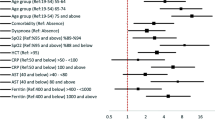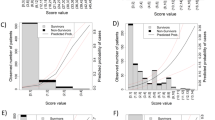Key summary points
Determining among 6 different scores which one most accurately predicted short-and long-term mortality in hospitalized COVID-19 patients above 60 years old.
AbstractSection FindingsAmong 6 different prognostic scales, the 4C Mortality Score (4CMS) was the best to predict intrahospital mortality and mortality at 30 days and 6 months. To predict 12-month mortality, the Charlson Comorbidity Index (CCI) had the best performance.
AbstractSection MessageThis study reflects the importance of considering comorbidities for short and long-term mortality after COVID-19.
Abstract
Background and objectives
Multiple scoring systems were used for risk stratification in COVID-19 patients. The objective was to determine among 6 scores which performed the best in predicting short-and long-term mortality in hospitalized COVID-19 patients ≥ 60 years.
Methods
An observational, retrospective cohort study conducted between 21/10/2020 and 20/01/2021. 6 scores were calculated (Clinical Frailty Scale (CFS), Charlson Comorbidity Index (CCI), 4C Mortality Score (4CMS), NEWS score (NEWS), quick-SOFA score (qSOFA), and Quick COVID-19 Severity Index (qCSI)). We included unvaccinated hospitalized patients with COVID-19 ≥ 60 years old in Brugmann hospital, detected by PCR and/or suggestive CT thorax images. Old and nosocomial infections, and patients admitted immediately at the intensive care unit were excluded.
Results
199 patients were included, mean age was 76.2 years (60–99). 47.2% were female. 56 patients (28%) died within 1 year after the first day of hospitalization. The 4CMS predicted the best intrahospital, 30 days and 6 months mortality, with area under the ROC curve (AUROC) 0.695 (0.58–0.81), 0.76 (0.65–0.86) and 0.72 (0.63–0.82) respectively. The CCI came right after with respectively AUROC of 0.69 (0.59–0.79), 0.74 (0.65–0.83) and 0.71 (0.64–0.8). To predict mortality at 12 months after hospitalization, the CCI had the highest AUROC with 0.77 (0.69–0.85), before the 4CMS with 0.69 (0.60–0.79).
Discussion
Among 6 scores, the 4CMS was the best to predict intrahospital, 30-day and 6-month mortality. To predict mortality at 12 months, CCI had the best performance before 4CMS. This reflects the importance of considering comorbidities for short- and long-term mortality after COVID 19.
Registration
This study was approved by the ethical committee of Brugmann University Hospital (reference CE 2020/228).


Similar content being viewed by others
Data availability
The datasets used and analyzed during the current study are available from the corresponding author on reasonable request.
References
Ghinai I, McPherson TD, Hunter JC et al (2020) First known person-to-person transmission of severe acute respiratory syndrome coronavirus 2 (SARS-CoV-2) in the USA. Lancet 395(10230):1137–1144
Straw S, McGinlay M, Drozd M et al (2021) Advanced care planning during the COVID-19 pandemic: ceiling of care decisions and their implications for observational data. BMC Palliat Care 20:10
Grasselli G, Zangrillo A, Zanella A et al (2020) Baseline characteristics and outcomes of 1591 patients infected with SARS-CoV-2 admitted to ICUs of the Lombardy Region, Italy. JAMA 323(16):1574–1581
Huang C, Wang Y, Li X et al (2020) Clinical features of patients infected with 2019 novel coronavirus in Wuhan, China. Lancet 395(10223):497–506
Farrell TW, Francis L, Brown T et al (2020) Rationing limited healthcare resources in the COVID-19 era and beyond: ethical considerations regarding older adults. J Am Geriatr Soc 68(6):1143–1149
Dumitrascu F, Branje KE, Hladkowicz ES, Lalu M, McIsaac DI (2021) Association of frailty with outcomes in individuals with COVID-19: a living review and meta-analysis. J Am Geriatr Soc 69(9):2419–2429
Rockwood K, Song X, MacKnight C et al (2005) A global clinical measure of fitness and frailty in elderly people. CMAJ 173(5):489–495
Charlson ME, Pompei P, Ales KL, MacKenzie CR (1987) A new method of classifying prognostic comorbidity in longitudinal studies: development and validation. J Chronic Dis 40(5):373–383
Tuty Kuswardhani RA, Henrina J, Pranata R, Anthonius Lim M, Lawrensia S, Suastika K (2020) Charlson comorbidity index and a composite of poor outcomes in COVID-19 patients: a systematic review and meta-analysis. Diabetes Metab Syndr 14(6):2103–2109
Jones A, Pitre T, Junek M et al (2021) External validation of the 4C mortality score among COVID-19 patients admitted to hospital in Ontario, Canada: a retrospective study. Sci Rep 11(1):18638
McGinley A, Pearse R (2012) A national early warning score for acutely ill patients. BMJ 345:e5310
Covino M, Sandroni C, Santoro M et al (2020) Predicting intensive care unit admission and death for COVID-19 patients in the emergency department using early warning scores. Resuscitation 156:84–91
Wibisono E, Hadi U, Bramantono S et al (2022) National early warning score (NEWS) 2 predicts hospital mortality from COVID-19 patients. Ann Med Surg 76:103462
Wang C, Xu R, Zeng Y, Zhao Y, Hu X (2022) A comparison of qSOFA, SIRS and NEWS in predicting the accuracy of mortality in patients with suspected sepsis: a meta-analysis. PLoS ONE 17(4):e0266755
Haimovich AD, Ravindra NG, Stoytchev S et al (2020) Development and validation of the quick COVID-19 severity index: a prognostic tool for early clinical decompensation. Ann Emerg Med 76(4):442–453
Izcovich A, Ragusa MA, Tortosa F et al (2020) Prognostic factors for severity and mortality in patients infected with COVID-19: a systematic review. PLoS ONE 15(11):e0241955
Romero Starke K, Reissig D, Petereit-Haack G, Schmauder S, Nienhaus A, Seidler A (2021) The isolated effect of age on the risk of COVID-19 severe outcomes: a systematic review with meta-analysis. BMJ Glob Health 6(12):e006434
Hanley JA, McNeil BJ (1983) A method of comparing the areas under receiver operating characteristic curves derived from the same cases. Radiology 148(3):839–843
Singh J, Malik P, Patel N, Pothuru S et al (2022) Kidney disease and COVID-19 disease severity-systematic review and meta-analysis. Clin Exp Med 22(1):125–135
Tan BWL, Tan BWQ, Tan ALM et al (2022) Long-term kidney function recovery and mortality after COVID-19-associated acute kidney injury: an international multi-centre observational cohort study. EClinicalMedicine 55:101724
Zheng Z, Peng F, Xu B et al (2020) Risk factors of critical & mortal COVID-19 cases: a systematic literature review and meta-analysis. J Infect 81(2):e16–e25
Li J, Huang DQ, Zou B, Yang H et al (2021) Epidemiology of COVID-19: a systematic review and meta-analysis of clinical characteristics, risk factors, and outcomes. J Med Virol 93(3):1449–1458
Johnson KJ, Goss CW, Thompson JJ, Trolard AM et al (2022) Assessment of the impact of the COVID-19 pandemic on health services use. Public Health Pract (Oxf) 3:100254
Mehta HB, Li S, Goodwin JS (2021) Risk factors associated with SARS-CoV-2 infections, hospitalization, and mortality among US Nursing Home Residents. JAMA Netw Open 4(3):e216315
Kastora S, Patel M, Carter B, Delibegovic M, Myint PK (2022) Impact of diabetes on COVID-19 mortality and hospital outcomes from a global perspective: an umbrella systematic review and meta-analysis. Endocrinol Diabetes Metab 5(3):e00338
Tahira AC, Verjovski-Almeida S, Ferreira ST (2021) Dementia is an age-independent risk factor for severity and death in COVID-19 inpatients. Alzheimers Dement 17(11):1818–1831
El-Sayed Moustafa JS, Jackson AU, Brotman SM et al (2022) ACE2 expression in adipose tissue is associated with cardio-metabolic risk factors and cell type composition-implications for COVID-19. Int J Obes 46(8):1478–1486
Galvin JE, Sadowsky CH; NINCDS-ADRDA (2012) Practical guidelines for the recognition and diagnosis of dementia. J Am Board Fam Med. 25(3): 367–382
Formiga F, Moreno-Gonzalez R, Chivite D, Franco J, Montero A, Corbella X (2018) High comorbidity, measured by the Charlson Comorbidity Index, associates with higher 1-year mortality risks in elderly patients experiencing a first acute heart failure hospitalization. Aging Clin Exp Res 30(8):927–933
Ek S, Meyer AC, Hedström M, Modig K (2022) Comorbidity and the association with 1-year mortality in hip fracture patients: can the ASA score and the Charlson Comorbidity Index be used interchangeably? Aging Clin Exp Res 34(1):129–136
Rottler M, Ocskay K, Sipos Z et al (2022) Clinical Frailty Scale (CFS) indicated frailty is associated with increased in-hospital and 30-day mortality in COVID-19 patients: a systematic review and meta-analysis. Ann Intensive Care 12(1):17
van Bruchem-Visser RL, Vankova H, Rexach L et al (2023) Scope of treatment and clinical-decision making in the older patient with COVID-19 infection, a European perspective. Eur Geriatr Med 14(1):43–50
Hussien H, Nastasa A, Apetrii M et al (2021) Different aspects of frailty and COVID-19: points to consider in the current pandemic and future ones. BMC Geriatr 21:389
Williams B (2022) Evaluation of the utility of NEWS2 during the COVID-19 pandemic. Clin Med (Lond) 22(6):539–543
Heldt S, Neuböck M, Kainzbauer N et al (2022) qSOFA score poorly predicts critical progression in COVID-19 patients. Wien Med Wochenschr 172(9–10):211–219
Fan G, Tu C, Zhou F et al (2020) Comparison of severity scores for COVID-19 patients with pneumonia: a retrospective study. Eur Respir J 56:2002113
Ebrahimzadeh S, Islam N, Dawit H et al (2022) Thoracic imaging tests for the diagnosis of COVID-19. Cochrane Database Syst Rev 5(5):CD013639
Funding
The authors did not receive support from any organization for the submitted work. The authors have no relevant financial or non-financial interests to disclose.
Author information
Authors and Affiliations
Corresponding author
Ethics declarations
Conflict of interest
The authors have no competing interests to declare that are relevant to the content of this article.
Ethics approval
This study was approved by the ethical committee of Brugmann University Hospital (reference CE 2020/228).
Informed consent
For this study informed consent was not necessary.
Additional information
Publisher's Note
Springer Nature remains neutral with regard to jurisdictional claims in published maps and institutional affiliations.
Supplementary Information
Below is the link to the electronic supplementary material.
Rights and permissions
Springer Nature or its licensor (e.g. a society or other partner) holds exclusive rights to this article under a publishing agreement with the author(s) or other rightsholder(s); author self-archiving of the accepted manuscript version of this article is solely governed by the terms of such publishing agreement and applicable law.
About this article
Cite this article
Van Hauwermeiren, C., Claessens, M., Berland, M. et al. Comparison of different prognostic scores in estimating short- and long-term mortality in COVID-19 patients above 60 years old in a university hospital in Belgium. Eur Geriatr Med 14, 1125–1133 (2023). https://doi.org/10.1007/s41999-023-00836-4
Received:
Accepted:
Published:
Issue Date:
DOI: https://doi.org/10.1007/s41999-023-00836-4




